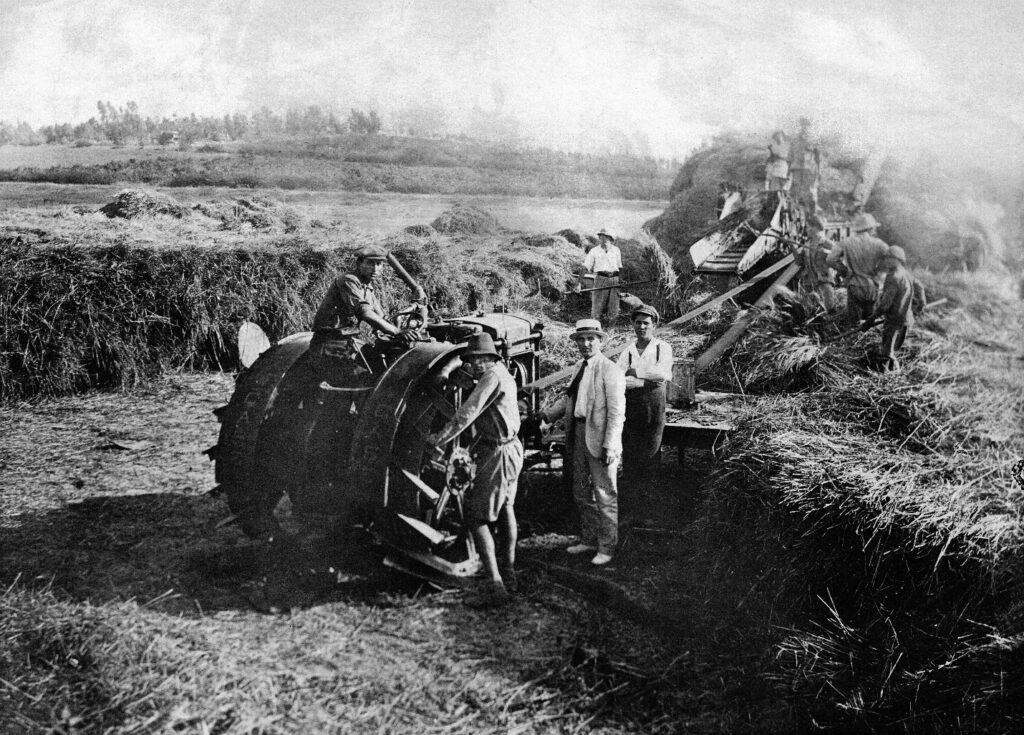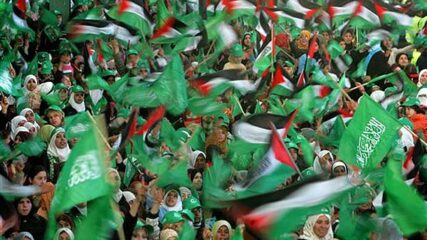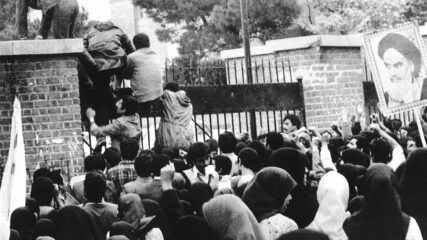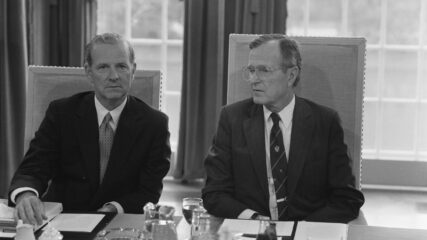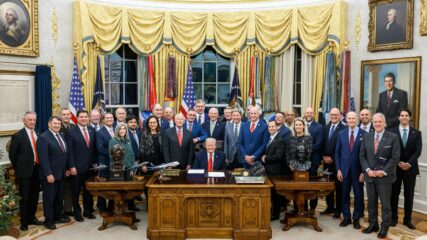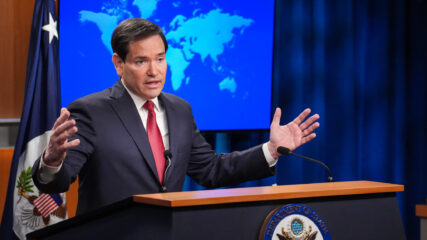Enumerable socio-economic differences separated the lives and the lifestyles of Arabs and Jews in Palestine in the period before 1948. Those differences had a direct impact on the ability and success of Jews/Zionists to establish a state. Discounting these factors or dismissing them for political reasons is an overt negation of fact. The communities were profoundly different in structure, economic well-being, and qualities of political leadership and commitment to communal bonds.
World War I in Palestine left an already highly precarious rural economy devastated. Subsequent disastrous consequences from the 1936-1939 Palestinian Arab Revolt against the British and Zionists were additional severe blows to Palestine’s majority rural population. In a broader comparative context, 19th and 20th century Arab society in Palestine was, as elsewhere in the Middle East, characterized by majority-Arab populations subsisting in rural agricultural settings with a very small number of Arab urban elites dominating the countryside’s economy and their relentless contribution to the peasantry’s annual impoverishment through high rental payments and perennial indebtedness through usurious lending rates.
Slowly and with difficulty, immigrating Jews to Palestine evolved their physical and economic presence primarily in the valley and coastal regions and notably not to any significant degree in the central hill regions running from Jenin in the north through Hebron in the south. Zionist institutions such as the Jewish Agency, Jewish National Fund, Anglo-Palestine Bank, Histadrut and Haganah served primarily the Jewish state in the making. Educational achievement levels and opportunities separated the communities as well.
In comprehending how the Zionists succeeded, socio-economic factors and communal characteristics played highly instrumental roles in shaping Palestinian Arab inabilities to compete with a smaller, often dynamic and terribly committed population. These socio-economic differences were evident and ongoing well before World War I and the advent of the British presence or knowledge of the Shoah and its consequences. The sources noted here tell only part of the story of the massive differences in literacy, economic viability and political adaptabilities of both communities. Socio-economic separation prefaced political partition.
— Ken Stein, April 3, 2022
The following information and citations were accumulated over four decades of research, taken from primary sources, namely documents, published by the British Palestine Administration, official documents of the British Foreign Office, from Arabic newspapers located at the National Library in Givat Ram at the Hebrew University of Jerusalem, from various records in the Central Zionist Archives in Jerusalem including the Political Department of the Jewish Agency, the Jewish National Fund Archives, and from the Palestine Administration Land and Land Registry Departments found at the Israel State Archives in Jerusalem. Some material is quoted from impeccable monographs and articles written by scholars whose research is unassailable.
The enduring question is how did the socio-economic differences between the Arab and Jewish communities in Palestine impact the political outcome in 1947-1948.
- Population of Palestine according to 1931 Census for Palestine (Palestine’s population in 1880, 24,000 Jews, 400,000 Arabs, both Muslims and Christians; in 1917, 65,000 Jews, 600,000 Arabs; in November 1947, 650,000 Jews, 1.2 million Arabs)
| Total Population | Total Rural Population | % Rural of Total | |
| Muslims | 753,812 | 571,637 | 75% |
| Jews | 172,028 | 56,143 | 32% |
| Christians | 87,870 | 22,148 | 25% |
| Others | 10,024 | 8,602 | 85% |
| TOTAL | 1,023,734 | 648,530 | 63% |
- Socio-economic issues in the Palestine Mandate, 1920-1948
Age in Years | Literate per thousand, 1931 Census for Palestine, Palestine Administration | ||||||||||||||
| All religions | Muslims | Jews | Christians | Others | |||||||||||
| Persons | Males | Females | Persons | Males | Females | Persons | Males | Females | Persons | Males | Females | Persons | Males | Females | |
| 5 & over | 309 | 404 | 211 | 135 | 234 | 32 | 834 | 903 | 765 | 555 | 683 | 427 | 199 | 343 | 101 |
| 7 & over | 326 | 428 | 221 | 144 | 251 | 33 | 861 | 934 | 787 | 577 | 715 | 441 | 233 | 362 | 104 |
- Only one fourth of the male and less than one thirtieth of the female Muslim population have been returned as literate: over 90 percent of the Jewish males and nearly 80 percent of the Jewish females have been returned as literate: the proportions for the Christians are about 90 percent for the males and rather more than two fifths for the females: while for the Druze the proportions are about one third for the males and one tenth for the females. The answer to the census question as to literacy is, according to the declarations of the people themselves, that the Jews are predominantly the literate community, the Christians taking second place, the Druze being third but considerably behind the Christians, while the Muslims are the most illiterate, being notably worse than the Druze. Great Britain. Palestine Government, Census for Palestine, 1931, p. 1032.
- Education — “The disturbing aspect of education in Palestine which must strike everyone who examines it is its separatist effect. It most countries education is a unifying force. Experience has shown that an educational system can be used to create a national culture and a common purpose while preserving local or racial characteristics and sometimes dialects or languages. In Palestine, education works the other way. The two main systems—the Jewish and the Arab or Government system — have no contact with one another. Theoretically, Jewish children may attend the Government Arab schools, and a few instances occur. There are also a few instances of the reverse. But for all practical purposes, the two systems are in watertight compartments. At the tope there is the Hebrew University of Jerusalem, which opens its doors to students of all nationalities and races, but in fact comprises only three Arab students in a total of 744. Arab students go to the University of Beirut, the University of Cairo, or to British, Continental, or American Universities. Moreover, one of the main purposes of Jewish education is to stress the importance of the Jewish National Home tends to increase the separatist effect. In the words of the Report of the Royal Commission of 1937 (p. 344) “the educational outlook, determined as it is by the provisions of Article 15, is disquieting. The existing Arab and Jewish schools systems are definitely widening and will continue to widen the gulf between the races.” Great Britain, Colonial Office, The System of Education of the Jewish Community in Palestine, 1945, London, 1946
- Over 440,000 [Arab] persons who are supported by ordinary cultivation, of whom 108,765 are earners and 331,319 are dependents. Of the earners 5,311 derive their livelihood from the rents of agricultural land, 63,190 persons cultivating their own land in whole or in part or cultivating lands which they hold as tenants. Almost the full number of rent-receivers is Muslims, for out of the total number of 5,311, only 10 are Jews, and 236 are Christians. The farmers, that is, the persons who cultivate either their own lands or the lands of a landlord, number 63,190 earners of whom 3,669 are Jews and 2,376 are Christians. The agricultural laborers number 29,077 earners, of whom 2,582 are Jews and 512 are Christians. The earners in this population number 108,376 and of these earners 26,240 or 24.2 percent have returned a subsidiary occupation. It is thus clear that nearly a quarter of the agriculturists would be unable to maintain their present standard of life if they were unable to find a secondary means of subsistence. Census for Palestine, 1931, Palestine, 1932.
- Jewish contribution to Mandate economy and operation
In 1928, while the Jewish population was only 17 percent of the total population, Jewish revenue contribution to the Palestine administration amounted to 44 percent of the administration’s revenue. (Great Britain, Parliamentary Debates, Commons, 17 November 1930, Remarks by Lloyd George, 5th Series, vol. 245; and Manchester Guardian, 3 April 1930.) In June 1936, a member of the Permanent Mandates Commission of the League of Nations that oversaw the trusteeships set up after World War I, noted that the Jews in Palestine contributed more to the Palestine public treasury than did the Arabs. (League of Nations, Permanent Mandates Commission: Minutes, Twenty-ninth Session, 8 June 1936, p. 140.) The Jewish share in Government revenue in 1944/45 is estimated at 65% whereas Jews constitute only 32% of the total population. Hence the Jewish contribution to Government income is four times per head greater than that of the rest of the population. (The Zionist Organization and the Jewish Agency for Palestine, Reports of the Executives submitted to the Twenty-Second Zionist Congress, Basle, Switzerland, December 1946, p.6)
- “In 1939, the Jewish community represented 31 percent of the total settled population; yet Jewish capital investment in industry represented 86 percent of the total net output. In the same year, Jewish workers constituted 79 percent of the total work force; salaries and wages paid to Jewish workers were 89 percent of the total wage bill.” See Jacob Metzer’s Divided Economy of Mandatory Palestine, Cambridge, 2002.
- 1938 assessment of the increase of Arab population due to – “It would seem that the growth of the population must be due mainly to a lower death-rate, brought about, not so much by a change in personal habits as by general administrative measures, such as anti-malarial control, under an efficient and enlightened government. We thus have the Arab population reflecting simultaneously two widely different tendencies- a birth-rate characteristic of a peasant community in which the unrestricted family is normal, and a death rate which could only be brought about under an enlightened modern administration, with both the will and the necessary funds at its disposal to enable it to serve a population unable to help itself. It is indeed an ironic commentary on the working of this Mandate, which so far from encouraging has almost certainly hindered close settlement by Jews on the land, could scarcely have been brought about except through the appropriation of tax-revenue contributed by the Jews.” [Paragraph 43] Great Britain Palestine Partition Commission Report, October 1938, Cmd. 5854, p. 27.
- Palestinian Arab economic condition — In 1925 Sir Herbert Samuel said that “large numbers of the Arab peasantry are exceedingly poor;” in 1931, Chaim Arlosoroff, the head of the Jewish Agency, noted that “the Bedouin of the south are on the threshold of starvation;” in 1932 Moshe Smilansky, working for the Jewish Agency, remarked that “in the Arab village nauseating poverty prevails.” Also in 1932, the Director of the Palestine Department of Lands noted that, “the fellah rarely had clear title [to his land] . . . and rarely ha[d] recourse to the formality of a regular mortgage with perhaps not 5% of the fellah’s land mortgaged formally.” In 1935, “Though it was reported that many fellaheen were appreciative of British efforts [to establish agricultural credit], the great majority of them were in a state of depression.” Remarks by Mr. Sydney Moody of the Palestine administration, League of Nations, Permanent Mandates Commission-Minutes. 1937, “the volume of the individual fellah’s indebtedness represented the full value of his annual income from crops and agricultural stock, or in other words his temporary wealth. His wealth was accordingly encumbered to the full, leaving him no surplus which could serve as security for credit where such was required to improve his farming. His annual indebtedness was 19L to 27L and the average annual rate of interest paid varied from 20 to 30 percent.” Great Britain, Palestine Royal Commission, “Rural Indebtedness.” Memoranda Prepared by the Government of Palestine, 1937. In December 1939, the Managing Director of the Jewish National Fund, Abraham Granovsky noted “that the Arabs were in monetary distress due to indebtedness.”
- Arab peasants, Arab landlords, majority population — “The fellaheen situation is … difficult as a result of terrorist activities throughout the country. It is estimated that not more than 50 percent of the fellaheen will be able to work their farms this year. In the first place, they have been forced to feed some 5,000 terrorists through the year. Whereas in 1937-38 the armed bands bought provisions from the peasant at good prices; this year, with the peasant completely intimidated by the bandits, the latter have requisitioned what they needed. The oil, olives, vegetables and other provisions from which the peasant makes his living and on which he subsists, have been eaten up by the bands which have quartered themselves on the villages. Many of the farmers have been left without seed, and even without work animals. It is estimated that their losses, counting the provisions taken by the bands, and the collective fines imposed on the villages by the Government for harboring the terrorists — whose presence they were powerless to resist — amount to at least half a million pounds.” Gershon Argronsky, Palestine Arab Economy undermined by Disurbances, Jerusalem, January 20, 1939, Central Zionist Archives, Record Group S25/file 10.
- One of the most important factors contributing to the indifferent character of ordinary cultivation as practiced by Arab agriculturists has been the system of tenure known as musha. Under this system relatively large groups of persons hold cultivable land in personal shares in undivided ownership, and each owner changes his holding at regular periods which vary with different localities. As a general rule, occupancy of a specific holding changes once in two years. This primitive tenure is, of course, not peculiar to Palestine: the theory of the tenure seems to be that the group of co-owners have common dominion over the whole land, each owner receiving as his holding the amount of land corresponding to his undivided interests of ownership; but, in order to assure equality of treatment to all co-owners, so that all have the same chance of good and bad land over a course of years, the occupancies are varied in rotation at stated periods. It is not difficult to believe that such a system of tenure is a democratic expression of the benevolence of a patriarchal system of social organization characteristic of eastern peoples. It will be comprehended that it is a system that is disastrous to efficient agriculture. The cultivator cannot, in such a system, develop his temporary holding because, if he does so, some other co-owner will later reap the fruits of his enterprise. In these circumstances it is satisfactory to learn that the system, once fundamental in the organization of the social group of the village, is rapidly breaking down by the voluntary agreement of the various co-owners: and it may be anticipated that the standard of cultivation will rapidly improve, particularly if it be found possible to provide the means by which cultivators can obtain capital on fairly easy terms. Palestine Administration, Census for Palestine, 1931.
- 1930 (in German) — “Those [Arab] effendis who have sold their own land to the Jews have enriched themselves; those fellaheen who sold directly to the Jews have likewise benefitted. Since, however, the sale of effendi estates has ended, the effendis have concentrated more and more on playing the middle-man, which is nothing but a base robbery of the fellaheen. The fellaheen have musha’ kushans
, the figures of the land area of which are written in such hieroglyphics that no one knows how many kushans he really owns and where the exact borders lie.
“The effendis settle such musha’ demands using pressure tactics and offer the fellah a lump sum, the relation of which to the actual number of the fellah’s dunams is not possible to assess. The fellah is tempted by the price, which has at least a clearly numbered and measurable value. The effendi buys a piece of property difficult to liquidate, the value of which is unknown even to him [the effendi]. In well-known and notorious cases, effendis have very recently bought land in this way for 20 piasters per dunam. The effendis need this land so that they can accumulate larger complexes [of land], that [were then] sold unsecured to the Jews for a price of about six pounds per dunam. Obviously, this method of short sale is widespread. It is done on the basis of a set dunam price, while the effendis, as I said, cover it afterwards with musha’ kushans. The fellaheen who relinquish their land in this manner often fall victim to poverty, all the more so because the effendis chased them from the land in a ruthless and brutal manner.
“Recently, the fellaheen who, through the spread of formal education, have learned very quickly and begun to grasp the consequences of this situation and have shut out the effendis and sell directly to the Jews. In this way they get the high price that the Jews are to paying and thereby become rich. The destruction of a lucrative procurement business is a terrible threat to the effendis, and there are people, and I count myself among them, who believe that all the agitation on the part of the effendis was just concocted as a great land speculation maneuver. Because the effendis are well aware that the Jews will continue to buy land in the long run, they have no fear of an interruption, but they must force the fellaheen to sell only to themselves and not the Jews. If the effendis are successful, they will have achieved two things: they will get away with paying the fellaheen even less for their land and demanding even more money from the Jews for it. That this is not simply pulled from the air can be demonstrated by the fact that the effendis who are ahead in this scam have by no means stopped making deals with the Jews. In most notable families there is somebody involved in this kind of sale, evidently by agreement. The PLDC and the JNF are now afraid to disturb the sales negotiations, which mean they will not reveal very much about these sales in commission discussions. We had prepared a whole black list of incriminated ‘Arab leaders’ who were to blame for indescribable corruption, but intervention prevent the list form being used or presented.
“I myself am very concerned about this development because we are made accomplices, abettors, or partners in crime in this corruption of the effendis, and our position in regards to the fellaheen is increasingly arousing suspicious and can only become dangerous.” Mr. Heinrich Margulies of the Anglo-Palestine Bank to Mr. Felix Rosenblueth, February 1930, Central Zionist Archives, (S25 series- political affairs), Jerusalem.
- Jewish state building- linking people to the land- Immigration and land, 1882-1947
- 1930-1931, separation or partition — “The question of the congestion amongst the fellaheen in the hill districts of Palestine is receiving the careful consideration of His Majesty’s Government. It is contemplated that measures will be devised for the improvement and intensive development of the land, and for bringing into cultivation areas which hitherto may have remained uncultivated, and thereby securing to the fellaheen a better standard of living without save in exceptional cases, having recourse to transfer.” In simple terms, HMG was reserving the hill regions of Palestine, namely Judea, Samaria, and the Upper Galilee for landless Arab resettlement. British House of Commons- Debates, 20 July 1931, cols. 1060-1064, vol. 255.
- 1930 — The Jewish economy met the needs of the Jewish population, not the Arabs in Palestine. Noting in 1930, a Jewish Agency Report stated, “It is not the primary aim and it cannot be the basis of Jewish industry to cater for the wants of 600,000 Arabs, three-quarter of whom are poor peasants.” The Jewish Agency, Land Settlement, Urban Development and Immigration, Memorandum submitted to Sir John Hope-Simpson, London, 1930, pp. 71-72.
- 1930 — “A modern capitalist industrial sector was being established by Jews to cater largely to the tastes of Western immigrants and the export market, to use as far as possible Jewish produced raw materials, and to create employment for Jewish workmen. And although this thrust toward separatism was inherent in Zionist ideology, British policy created a suitable environment for its growth. By the end of the [1920s] decade, it was clear that British policy had unwittingly paved the way for the development of a Jewish industrial enclave with few ties with the indigenous population.” Barbara J. Smith. The Roots of Separatism in Palestine, British Economic Policy, 1920-1929, Syracuse, 1993, p. 181.
- 1944 — British High Commission for Palestine recommends partition of the country into two states.
- Arab land sales to Jews — A Tulkarm landlord, A.L. Tibawi petitioned the district officer of Samaria, H.M. Foot sought to develop his land which was partially cultivated by hired labor under the landlord’s supervision and partially cultivated by tenants, who he wished evicted. Tibawi in his petition said that the three tenants’ income was far less than that cultivated by the hired laborers. Moreover, said Tibawi, “the tenants not only ceased to contribute their share to the income [from the land], but also failed to pay the government taxes.” Tibawi sought “the immediate eviction of the tenants because their presence threatened his future with serious material loss.” “Landlords,” he said, “must maintain a high standard of living which would not be fair to compare to that of the tenants.” [The British administrative official, H.M. Foot ultimately ruled that the three tenants had sufficient land elsewhere for their livelihood and allowed A.L. Tibawi to resume his holding Abdul Latif Tibawi vs. Tenants Kamil Amrur, Abdul Fattah Amrur, and Abdul Hafiz Amrur, File TR/114/33. Tibawi to Assistant District Commissioner, Nablus, November 16, 1934, Box 3922, Israel State Archives, Jerusalem, Israel.
- Palestinian Arab Newspapers — al-Hayat, 23 January 1931 — “The Tulkarm Arabs are busy selling their lands to Jews through the mediation of certain brokers.”
- al-Jami’ah al-Islamiyyah, 21 August 1932 — “Because the Jews are alert, and our leaders are asleep, the Jews are buying the lands.”
- al-Jami’ah al-Islamiyyah, 2 September 1932 — “The Arab will never regard these sales as legal although the Jews possess the titles to these lands; and when political conditions change, the Arabs will demand that their lands be given back to them because they were sold in very extraordinary [circumstances].”
- al-Jami’ah al-Arabiyyah, 24 May 1934 — “The situation is unbearable and our lands are now falling on easy prey into the hands of the raiders. The brokers are increasing every day among various classes of rich and poor people who have been dazzled by the Zionist gold.”
- Al-Jam’iah al-Islammiyah, 22 January 1936 — “It is on our leader’s shoulders that our calamity of land sales lies. They themselves as well their relatives were guilty of selling lands to the Jews.”
- At the very peak of the 1936 revolt the three visiting U.S. senators (Copeland, Austin and Hastings) found that “while the Arab High Committee in charge of the [Arab civil] strike is officially demanding prohibition of the sale of land to Jews, some of the prominent Arab leaders active in that Committee are quietly trying to sell land to Jewish buyers.” William Ziff, The Rape of Palestine, Longmans Green, 1938, p.39 “Report of the Senators Mission,” New York American, October 1, 1936.
- December 1937 — “We have already acquainted you with the fact that, as foreseen by the JNF management, the disturbances in Palestine have brought about a considerable increase in the offers of land for sale.” At a meeting of the Board of Directors held on December 6 a report was submitted showing that these offers were on a scale unprecedented since the World War. If means were available, contracts could be closed for 200,000 dunams in various parts of the country, including both areas in the projected Jewish and Arab State, and on their borders, with an undertaking on the part of the vendors to complete the transaction in a short time. Of these offers at least 150,000 dunams have been examined and found satisfactory in respect of lands in Upper Galilee, Districts of Beisan and Acre, Judean Hills (the “British corridor” — Jerusalem to Tel Aviv) and in the south. The acquisition of this territory would require an 1,100,000 additional, [above] of course, to the regular budget of the JNF.
At this meeting of the Board of Directors, Mr. Ben-Gurion stressed the political significance of land purchase at the present time. It was most probable that in the event of partition, the scheme of the Royal Commission would be modified positively and negatively. Certain areas in Galilee were endangered, and in consequence land purchase now by the JNF had an additional value, above its intrinsic merits. Mr. Ben-Gurion referred to it as not less than the rescue of the homeland.
It was conceivable that the acquisition, and settlement or occupation, of land on the far side of the borders as now delimited of the Jewish State, would influence the Boundaries [Woodhead] Commission to extend those borders. This would not be the sole factor operating, but in addition to others, would be influential. He emphasized the northern and southern boundaries, because there the position seemed to him to be clear. He believed that the Negev would not be included in the Arab State, but would be under British control.” [Of the lands suggested for purchase, the JNF purchased more than 50,000 of the dunams mentioned in this letter here, establishing eventually more than 20 kibbutzim between 1939 and 1945, many of them in the upper Galilee]. JNF Information Circular No.2/98, Strictly Confidential, 31 December 1937, CZA, KKL 5.
- Arab land sales to Zionists, continued, June 1940 — “The Arab landowner [needed] to be protected against himself,” Remarks by Sir John Shuckburgh, 14 June 1940, CO 733/425/75872, Part 2. (CO =Colonial Office Files 733 is the British Record Group for correspondence of the Palestine Mandate).
- April 1945 — “In view of the publicity that is now given to the sale of land in execution proceedings, it can be reasonably assumed that evasions of the Regulations can only occur with the acquiescence if not the connivance of that section of the population which the Regulations were designed to protect.” Letter for Sir William James Fitzgerald (British official in Chief Secretariat of Palestine) to Chief Secretary of the Palestine Administration, 10 April 1945, ISA, Box M397, SF215/40 Folio 166.
- April 1945 — “The JNF were being inundated with offers from Arab sellers and made isolated contracts for completion of purchases after the war in full assurance that the (LTR)regulations would be repealed with HMG have sufficient time to apply itself to the subject.” Letter from Director of Land Registrations to Chief Secretary of the Palestine Administration, 24 April 1945, ISA, Box M397, SF 215/40 Vol. 1.
- November 1946 (Hebrew) — “Dr. Granovsky, managing director of the JNF: noted that “Three years ago, when a similar council met, the tightening of our ability to purchase lands was strongly felt. Now the tightening is becoming even more severe. In these past seven years [1940 to end of 1946] 46% of [all] Jewish National Fund land was purchased, among them 152,000 dunams from Jews and 238,000 dunams from Arabs. … There stands before us the possibility of acquiring between 200 and 250 thousand dunams annually.” Minutes of the decisions of a Jewish National Fund meeting concerned with land acquisition, Minutes of the JNF Directorate Meeting, November 10, 1946, Jewish National Fund archives, Central Zionist Archives, Jerusalem.
- Palestine’s economy before 1948 — “World War II had an enormous impact upon the growth of Palestine’s economy and particularly the growth of the Jewish sector. First, ‘the war welded the Middle East into one economic entity; the Mediterranean was invested with enemy submarines…all endeavors had to be made to save shipping space [for war related needs]making the Middle East self-sufficient as possible …it led to local production in both agriculture and industry and accelerated the process of industrialization. In the war period, the number of earners in the Jewish economy increased by 55,000 by 29 per cent while the Jewish population increased by 21 per cent … unemployment [in the Jewish sector] being very limited in scope and mainly frictional, i.e. workers between one job and another.” David Horowitz, “Economy in Transition in Palestine,” in Sophie A. Udin (ed.), The Palestine Yearbook 5707, Vol. II,(Review of Events of July 1945 to September 25, 1946, New York: Zionist Organization of America, 1946, pp. 102-10.
- This flow [of Jewish capital imports] accounted, in 1932-1946, forming at least 85 per cent of the influx of long term capital to Mandatory Palestine from all sources combined. … For the entire Mandatory period Jewish capital investment accounted for 60 per cent of the addition to Palestine’s overall fixed capital formation. For the entire Mandate Jews invested 72,929,000 LP (60.2%), the Arabs (34,811,000 LP (28.7%), the British Government, (13,449,000LP (11.1%).” Jacob Metzer, The Divided Economy of Palestine, Cambridge, 1998, p. 104-05.
- The implications of this availability of capital allowed the Jewish sector to grow phenomenally, not from British taxpayer funds or subventions from the British government, or intrusion into the financial or monetary sector by Britain to protect the Jewish economy, but from capital imported by Jews for the Jewish economy. This allowed the Jewish economy before WWII, to undertake massive investments without having to resort to borrowing or to domestic savings. The imported capital by Jews came from primarily (75% private sources) consisting mostly of immigrant transfers. Capital was not sufficient to create jobs, increase demand, generate supply..what was required banking, financial, and mortgage institutions, numbering more than half a dozen which primarily serviced the Jewish economic sector. See Jacob Metzer, The Divided Economy of Palestine, Cambridge, 1998, pp. 105-115.
- What contributed to the Palestinian Arab society collapse 1940s forward — “Decades of social change clearly contributed to [the Palestinian Arab] communal collapse and flight in the months of 1948- that is, rapid and chaotic breakdown and disintegration of village and urban political and social organization and leadership. In the context of an absent Palestinian national authority, the early flight of thousands among the upper and middle classes, and a colonial government that was hurriedly evacuating the country, there was no body that could coordinate and organize resistance and maintain basic public services to avert the widespread collapse of communal institutions and authority. ” Issa Khalaf, “The Effect of Socioeconomic Change on Arab Societal Collapse in Mandate Palestine,” International Journal of Middle East Studies, vol. 29, No. 1 (February 1997), pp. 93-112.
- 1946 — “The [Palestinian] Arabs are divided politically by the personal bickering of the leaders, which still center round the differences of the Husseinis and their rivals; and socially by the gap which separates the small upper class from the mass of the peasants — a gap which the new intelligentsia is not yet strong enough to bridge. Consequently they have developed no such internal democracy as have the Jews. That their divisions have not been overcome and a formally organized community developed is in part the result of a less acutely self-conscious nationalism that is found today among the Jews. It is, however, also the outcome of a failure of political responsibility. The Arab leaders, rejecting what they regard as a subordinate status in the Palestinian State, and viewing themselves as the proper heirs of the Mandatory Administration, have refused to develop a self-governing Arab community parallel to that of the Jews. Nor, so far, have they been prepared to see their position called in question by such democratic forms as elections for the Arab Higher Committee, or the formation of popularly based political parties. This failure is recognized by the new intelligentsia which, however, is unlikely to exercise much power until it has the backing of a larger middle class.” “Arab Leadership” as quoted in the Report of the Anglo-American Commission of Inquiry, 1946, Page 36. See also Arab views on the Palestinian Arabs’ Dysfunctional Condition, 1945-1949.
- Zionists seeking compromise with Arabs countries, September 1947 — “He [Jon Kimche] phoned one morning, out of a clear sky, and said it was possible to arrange an interview with Abdul Rahman Azzam Pasha, leader and secretary-general of the Arab League. I [David Horowitz] opened the conversation. After setting out my view of UNSCOP’s report, I turned to analyze the situation: “The Jews are a fait accompli in the Middle East. Sooner or later the Arabs will have to reconcile themselves to the fact and accept it. You Arabs cannot wipe out or exterminate over a half a million people. We, for our part, are genuinely desirous of an agreement with the Arabs and are prepared to make sacrifices for one.
“The plan is in three parts. First, political: that is, an arrangement with the Arab League based on a system of well-defined rights and obligations. Secondly, security, which will have the effect of dissipating your groundless suspicions of our alleged expansionist ambitions, though we keep on declaring and repeating that our sole object is to in-gather the hundreds of thousands of our brethren within the bounds prescribed for us to revive the wilderness, and despite the fact that any attempt on our part to break out of this frame will be met with the opposition of the entire world. Finally, the plan will have an economic section to be drawn up in consultation between the parties and will deal with the conjoint development of the Middle East, to the advantage and prosperity of the Arab masses.”
Azzam Pasha: “The Arab world is not in a compromising mood. It’s likely, Mr. Horowitz, that your plan is rational and logical, but the fate of nations is not decided by rational logic. Nations never concede; they fight. You won’t get anything by peaceful means or compromise. You can, perhaps, get something, but only by the force of arms. We shall try to defeat you. I’m not sure we’ll succeed, but we’ll try. We were able to drive out the Crusaders, but on the other hand we lost Spain and Persia. It may be that we shall lose Palestine. But it’s too late to talk of peaceful solutions.”
Aubrey Eban: “The UNSCOP report establishes the possibility of a satisfactory compromise. Why shouldn’t we at least make an effort to reach an agreement on those lines? At all events, our proposal is a first draft only and we shall welcome any counterproposal from your side.”
Azzam Pasha: “An agreement will only be acceptable at our terms. The Arab world regards you as invaders and is ready to fight you. The conflict of interests among nations is, for the most part, not amenable to any settlement except armed clash” David Horowitz, State in the Making, New York: Alfred Knopf, 1953, pp. 233-235.

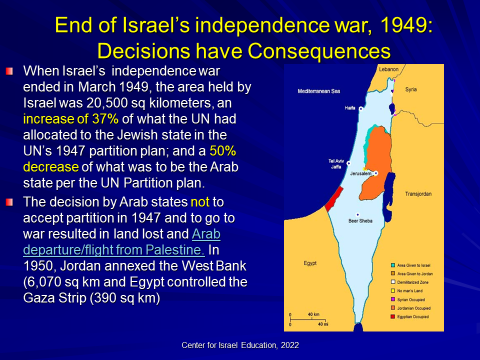
- November 1947 — “In determining the final partition map that was authorized by the UN in November 1947, Zionist interests were presented in a clear-cut fashion by a [Moshe]Shertok and Zalman Lifshitz. These two people played a central role in defining the [Jewish Agency] Executive’s partition map in 1938. It is hard not to detect in the …UNSCOP Report, Zionist fingerprints…that determined the Agency Partition Map of 1938.” Yossi Katz, Partner to Partition The Jewish Agency’s Partition Plan in the Mandate Era, London, Cass, 1998, p. 182. 1947 U.N. Suggests Partition of Palestine Into Arab and Jewish States, Arab countries reject idea.
- February 1948 — “Because of the present (political) situation there is a temporary break in relations between us (JNF) and the owner of land and Arab sellers; but the contacts between us (JNF) and them is not broken. They are seeking to sell land because they are in financial distress and need the money. Indeed there are no possibilities to transfer today their land to the name of the JNF at the land registry office as it was once possible.” CZA, KKL 10, Remarks by Joseph Weitz, ‘Land Purchase Situation,” Minutes of the Directorate of the Keren Keyemeth, February 3, 1948.
- Israel’s Declaration of Independence, May 1948
- July 1948 (Hebrew) — “With the establishment of the State of Israel, about 300,000 Arabs – urban and village – owners of the area and fellaheen, left [Eretz Yisrael-Palestine] during the recent months of war. Within the boundaries of the State of Israel, 150,000 Arabs from 190 villages left. (‘azvu). The overall area of the villages is about 1,400,000 dunams, a portion belong to owners living outside [Eretz Yisrael-Palestine], a portion belonging to local Arabs, and a portion to fellaheen. The question of possibilities for the JNF to purchase land relates to its [ownership] source. …with regard the land belong to the local [Palestinian] Arab owners, who presently outside of [Eretz Yisrael-Palestine], today it is possible to contact these owners who are now in Europe.” Remarks by Mr. Joseph Weitz, Coordinator of land acquisition for the Jewish National Fund, Minutes of the decisions of the Jewish National Fund meetings, July 1948, Jewish National Fund archives, Central Zionist Archives, Jerusalem.

